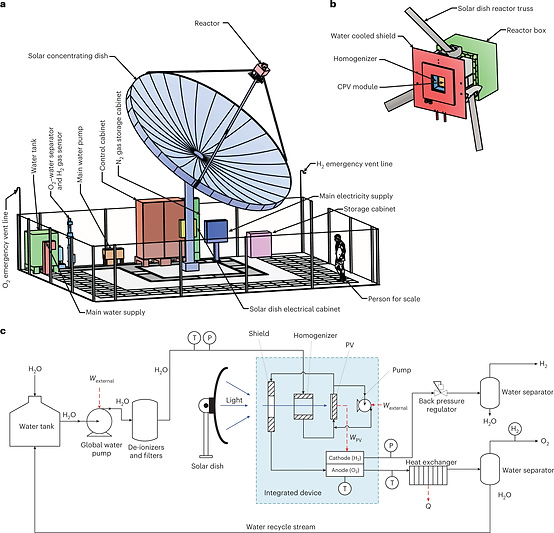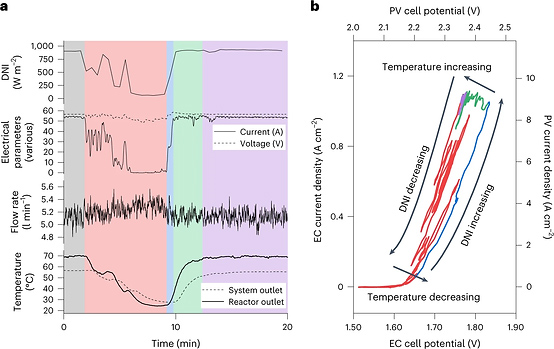|

Groundbreaking solar reactor efficiently generates
oxygen, hydrogen and usable heat
21 April 2023

Groundbreaking system uses a parabolic dish to
concentrate solar radiation nearly 1,000 times and convert
water into hydrogen, oxygen. (CREDIT: LRESE EPFL)
EPFL scientists have developed a groundbreaking
system that uses a parabolic dish to concentrate solar radiation
nearly 1,000 times and convert water into hydrogen, oxygen, and heat.
The dish, which resembles a satellite dish or other telecommunications
infrastructure, works like an artificial tree.
The reactor above the dish uses sunlight to convert water into
hydrogen and oxygen, while the heat generated is passed through a heat
exchanger so it can be harnessed for ambient heating. The system is
suitable for industrial, commercial, and residential applications and
could power hydrogen fuel cells, provide residential and commercial
central heating and hot water, and split carbon dioxide instead of
water.
The research team, led by Sophia Haussener, head of the Laboratory of
Renewable Energy Science and Engineering (LRESE) in the School of
Engineering, recently published the results of their scaled-up,
efficient, and multi-product process under real-world conditions in
the journal Nature Energy.
The team's work builds on preliminary research demonstrating the
concept on the laboratory scale, using LRESE's high-flux solar
simulator, which was published in the same journal in 2019.
According to Haussener, "this is the first system-level demonstration
of solar hydrogen generation. Unlike typical lab-scale demonstrations,
it includes all auxiliary devices and components, so it gives us a
better idea of the energy efficiency you can expect once you consider
the complete system, and not just the device itself."
The hydrogen production rate achieved in this work represents a
significant step towards the commercial realization of this
technology. With an output power of over 2 kilowatts, the team has
cracked the 1-kilowatt ceiling for their pilot reactor while
maintaining record-high efficiency for this large scale.
The EPFL campus system has an output level of about half a kilogram of
solar hydrogen per day. This amount could power around 1.5 hydrogen
fuel cell vehicles driving an average annual distance or meet up to
half the electricity demand and more than half of the annual heat
demand of a typical four-person Swiss household.
In addition to the system's primary outputs of hydrogen and heat, the
oxygen molecules released by the photo-electrolysis reaction are also
recovered and used. "Oxygen is often perceived as a waste product, but
in this case, it can also be harnessed – for example for medical
applications," Haussener says
The system is suitable for industrial,
commercial, and residential applications. In fact, LRESE spin-off
SoHHytec SA is already deploying and commercializing it. The EPFL
start-up is working with a Swiss-based metal production facility to
build a demonstration plant at the multi-100-kilowatt scale that will
produce hydrogen for metal annealing processes, oxygen for nearby
hospitals, and heat for the factory's hot-water needs.
"With the pilot demonstration at EPFL, we have achieved a major
milestone by demonstrating unprecedented efficiency at high output
power densities. We are now scaling up a system in an artificial
garden-like setup, where each of these 'artificial trees' is deployed
in a modular fashion," says SoHHytec co-founder and CEO Saurabh
Tembhurne.

Overview of the system. Technical illustration of
the overall site showing key components such as the solar parabolic
concentrator dish, reactor and ancillary hardware and cabinets.
(CREDIT: Nature Energy)
The system could also be used to power hydrogen fuel cells, provide
residential and commercial central heating and hot water, and split
carbon dioxide instead of water. Haussener is already exploring new
technological avenues, and the lab is working on a large-scale
solar-powered system that would yield useful materials like syngas for
liquid fuel or the green plastic precursor ethylene.
The potential of the artificial photosynthesis system to split carbon
dioxide instead of water is immense. Carbon dioxide is a major
greenhouse gas that is emitted as a result of burning fossil fuels. By
capturing and using this gas to produce useful materials, the EPFL
researchers hope to contribute to the fight against climate change.

Experimental dynamic response to fluctuating DNI
(21 August 2020 16:10:00 to 16:30:00). (CREDIT: Nature Energy)
“Carbon dioxide is a very stable molecule, and
breaking it down requires a lot of energy,” Haussener explains. “But
we can use solar energy to provide that energy, and then split carbon
dioxide into its component parts, like syngas or ethylene.”
The technology has already been demonstrated on a laboratory scale,
but scaling it up for commercial use is a major challenge. However,
Haussener and her team are optimistic about the potential of their
system.
“We’re looking at building large-scale reactors that could be used in
industrial settings, where carbon dioxide emissions are high,” she
says. “This could be a game-changer for industries like steel and
cement production, which are major sources of carbon dioxide
emissions.”
The EPFL researchers are not the only ones working on artificial
photosynthesis technology. Researchers around the world are exploring
different approaches to using solar energy to produce hydrogen and
other valuable products.
Some of the challenges facing the technology include the need for
high-quality solar radiation, the cost of materials and manufacturing,
and the need for efficient and durable catalysts to drive the chemical
reactions.
Despite these challenges, the potential of artificial photosynthesis
is huge. If it can be scaled up and commercialized, it could be a
major source of renewable energy and a key player in the fight against
climate change.
As for the EPFL system, it is already making an impact. SoHHytec SA
has received funding from the Swiss government to build a
demonstration plant that will use the technology to produce hydrogen
for industrial applications. The start-up is also exploring
partnerships with other industries and potential applications for the
system.
Haussener is excited about the possibilities.
“This is a really exciting time for renewable energy,” she says. “We
have the technology and the knowledge to make a real impact on climate
change. We just need to keep pushing forward and finding new ways to
harness the power of the sun.”
For more science and technology stories check out our New Innovations
section at
The Brighter Side of News.
Green Play Ammonia™, Yielder® NFuel Energy.
Spokane, Washington. 99212
509 995 1879
Cell, Pacific Time Zone.
General office:
509-254
6854
4501 East Trent
Ave.
Spokane, WA 99212
|